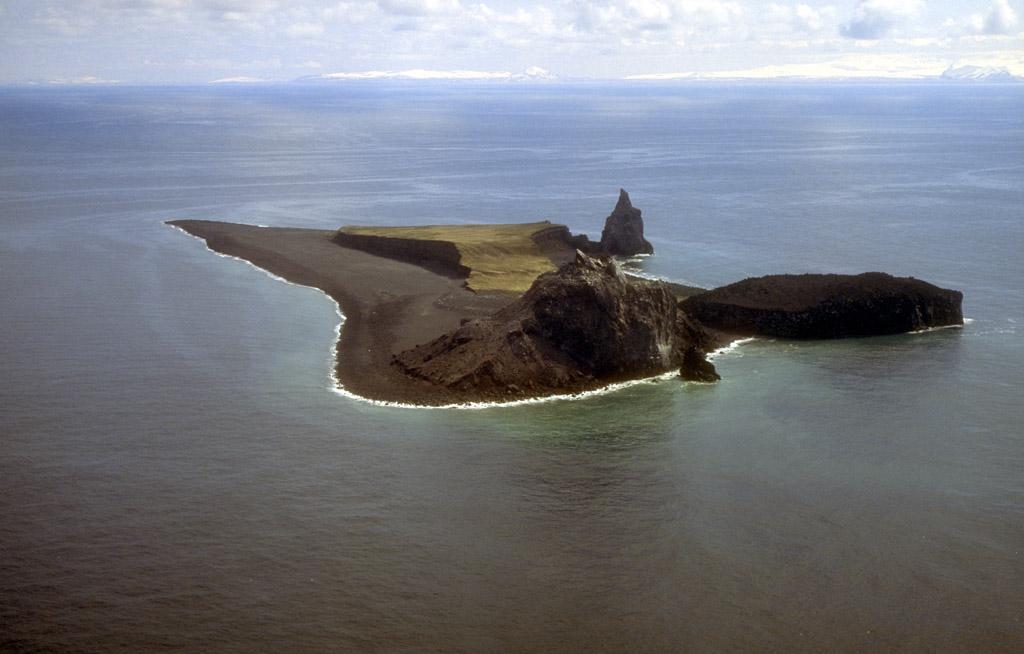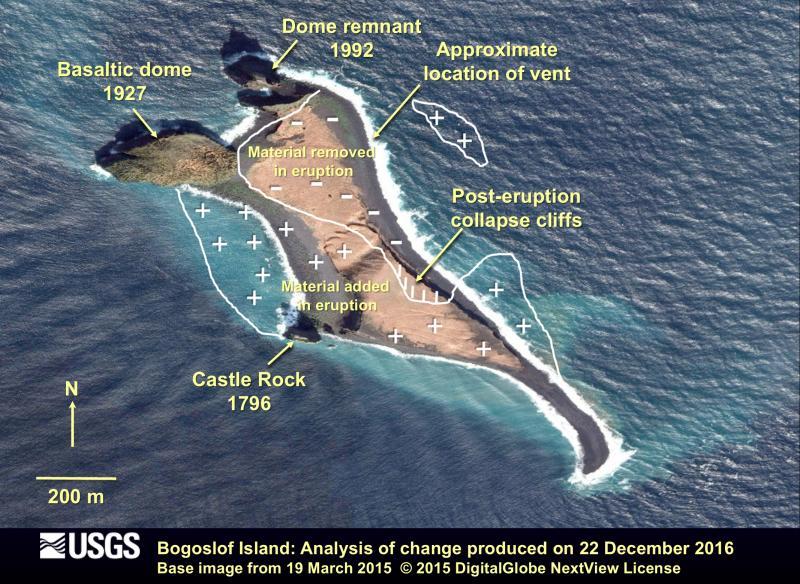
Update: 12/23 at 12:21 p.m.
For the third time in as many days, Bogoslof volcano has erupted.
The Alaska Volcano Observatory (AVO) has issued its highest alert level for air travel.
The volcano is on a uninhabited island 60 miles northwest of Unalaska.
The eruption on Dec. 23 blew ash 30,000 ft. into the air and ejected lava.
Experts cannot predict how long the eruption might last because there is no monitoring equipment on Bogoslof.
The last time this volcano erupted was in 1992, and it lasted a month.
Update: 12/22 at 3:55 p.m.
After two eruptions in as many days, scientists are closely watching a volcano in the eastern Aleutians. There’s no equipment on Bogoslof volcano, but The Alaska Volcano Observatory is keeping tabs with satellite imagery and nearby seismic monitors.
Bogoslof volcano is tiny — like city park tiny. The uninhabited island is less than a quarter of the size of Central Park in New York City.
Michelle Coombs, a scientist with the Alaska Volcano Observatory, said the recent Bogoslof eruptions have produced some new land.

“We have new observations from today that suggest the new vent is offshore of the little island and has destroyed part of Bogoslof island but also has produced new land,” Coombs said.
But Coombs said because the new vent is underwater, interpreting seismic activity is more difficult.
Typically when there’s an eruption, seismic waves move through the ground.
With underwater vents, scientists get two sets of waves — the expected waves moving through the ground and another set of distorted waves that travel through the water.
At this point, Coombs said it’s hard to predict how much longer the Bogoslof eruption will last.
“I wish we had a crystal ball and could say the exact sequence,” Coombs said. “We definitely don’t have that capability. We’re even more limited in this situation because it’s such a small island we do not have any local seismic monitoring instruments on the island.”
Based on past eruptions on the island, Bogoslof could be active for weeks or even months.
Update: 12/21 at 3:15 p.m.
A volcano in the eastern Aleutians erupted suddenly Dec. 20 prompting the Alaska Volcano Observatory (AVO) to issue its highest alert level for aviation. The alert has since been downgraded.
Bogoslof volcano is on an uninhabited island 60 miles northwest of Unalaska.
AVO scientist Michelle Coombs said several pilots reported seeing an ash cloud at about 34,000 ft in altitude — about the same height as the cruising altitude for large jet planes.
She said satellite data show a short-lived explosion occurred around 4 p.m., but the activity has since died down.
Coombs said the volcano seems to have erupted because it was “gassy.”
“It looked like it had a lot of gas in it — a lot of sulfur gas and probably water gas,” Coombs said. “[The eruption] might have been the opening event in possible the eruptive sequence.”
It’s an eruptive sequence that might include new land forming.
The area is very dynamic. Coombs said over the years the shape, height and number of islands have changed. Since the 1700’s, Bogoslof has erupted 8 times and Coombs said it’s hard to know how long this eruption will last.
Eruptions are like personalities.
“Some volcanoes tend to erupt have a big explosive eruption and then go back to sleep,” Coombs said. “A lot of volcanoes have more longer-lasting, low-level activity.”
She said long eruptions — lasting weeks or months — are common in Alaska.
Because there is no ground-based monitoring equipment on Bogoslof volcano, the AVO cannot predict future eruptive activity. Instead, it is monitoring from afar — using satellite images and other data for indications of significant seismic activity.
If this eruption continues it could impact aviators, mariners and drop ash on nearby communities.
Prior to this, the last recorded eruption of Bogoslof was in 1992 and lasted nearly a month.
ORIGINAL STORY:
A volcano in the eastern Aleutians erupted suddenly Tuesday afternoon. The Alaska Volcano Observatory (AVO) said several pilots reported seeing an ash cloud about 34,000 feet above Bogoslof volcano.
Bogoslof volcano is on an uninhabited island 60 miles northwest of Unalaska.
The observatory said a short-lived explosion occurred at 4pm Tuesday, but the activity has died down. For now, the AVO and U.S. Geological Survey (USGS) has raised the aviation code to “red” and the alert level to “warning.”
Because there is no-ground based monitoring equipment on Bogoslof volcano, the AVO cannot predict future eruptive activity. Instead, it will monitor from afar — using satellite images and other data for indications of significant seismic activity.
Prior to this, the last recorded eruption of Bogoslof was in 1992.
Zoe Sobel is a reporter with Alaska's Energy Desk based in Unalaska. As a high schooler in Portland, Maine, Zoë Sobel got her first taste of public radio at NPR’s easternmost station. From there, she moved to Boston where she studied at Wellesley College and worked at WBUR, covering sports for Only A Game and the trial of convicted Boston Marathon bomber Dzhokhar Tsarnaev.




